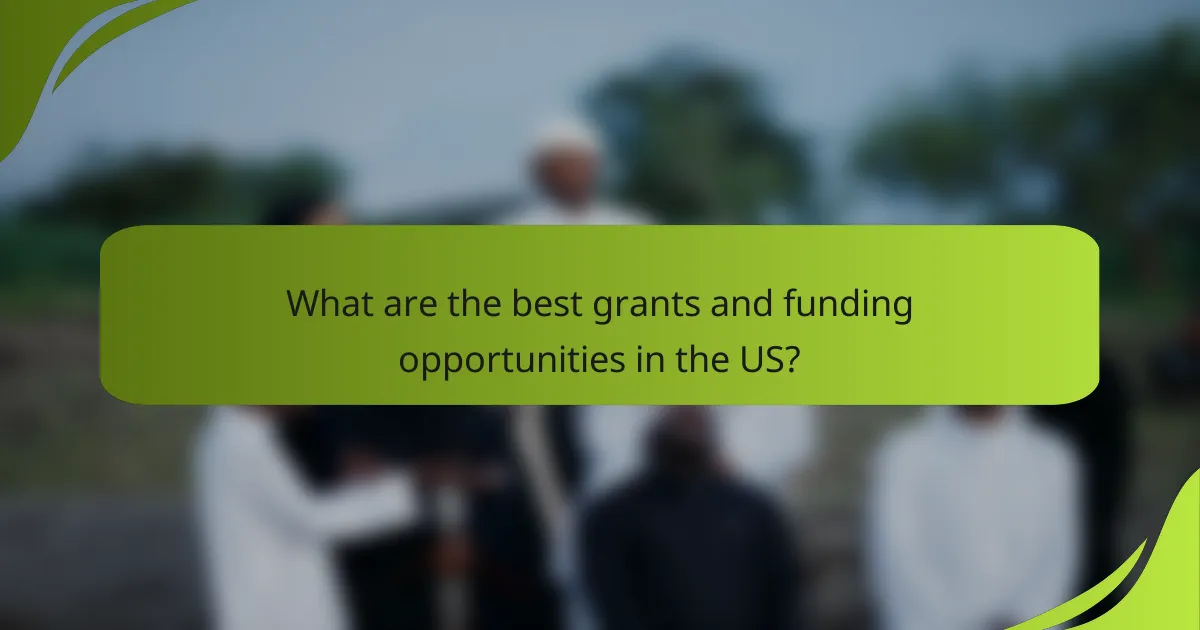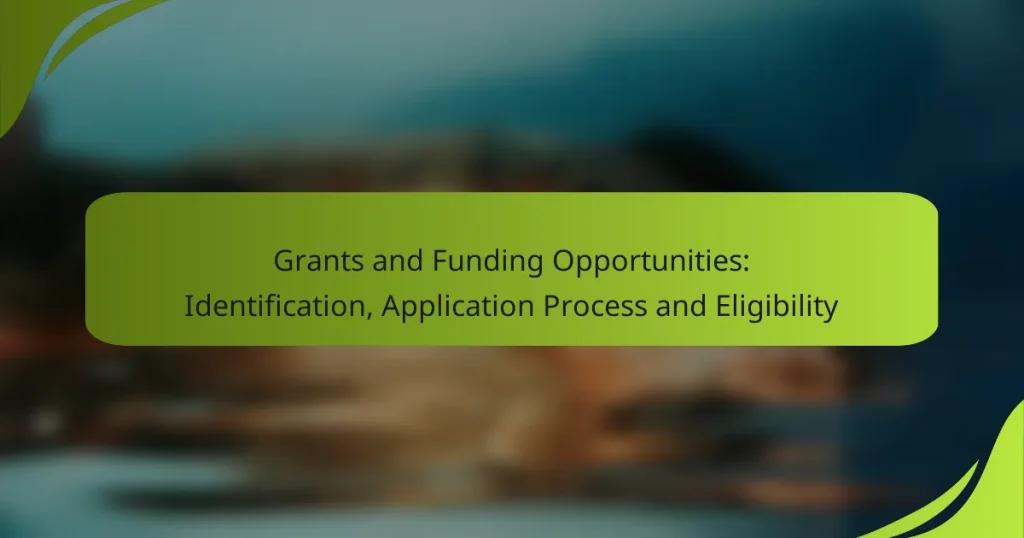Grants and funding opportunities in the US offer vital financial support for various sectors, including research, small businesses, and the arts. Identifying the right grants requires thorough research into eligibility criteria and application processes, which can differ significantly. By understanding these steps, applicants can enhance their chances of securing funding for their projects or organizations.

What are the best grants and funding opportunities in the US?
Some of the best grants and funding opportunities in the US include federal and state programs designed to support research, small businesses, community development, the arts, and education. These grants can provide significant financial assistance, but eligibility and application processes vary widely.
National Science Foundation Grants
The National Science Foundation (NSF) offers grants to support research and education in science and engineering. These grants are typically awarded to academic institutions, researchers, and sometimes small businesses, focusing on innovative projects that advance knowledge and technology.
To apply, organizations must submit a proposal that outlines the project’s objectives, methodology, and potential impact. It’s essential to adhere to NSF guidelines and deadlines, as proposals are highly competitive.
Small Business Innovation Research Program
The Small Business Innovation Research (SBIR) Program provides funding to small businesses for research and development with the potential for commercialization. This program is crucial for startups looking to innovate and bring new technologies to market.
Eligible businesses can receive funding in phases, starting with feasibility studies and moving to full research and development. Applicants should focus on demonstrating the commercial viability of their projects and align with federal agency interests.
Community Development Block Grants
Community Development Block Grants (CDBG) are federal funds allocated to local governments to support community development projects. These grants aim to improve housing, infrastructure, and economic opportunities for low- and moderate-income individuals.
To access CDBG funds, local governments must develop a consolidated plan that outlines their community needs and proposed projects. It’s important for applicants to engage with community stakeholders to ensure that the projects align with local priorities.
National Endowment for the Arts Funding
The National Endowment for the Arts (NEA) provides grants to support artistic projects and organizations across the country. This funding is available for a variety of disciplines, including visual arts, music, theater, and literature.
Organizations applying for NEA funding must demonstrate artistic excellence and public engagement. It’s beneficial to clearly articulate how the project will impact the community and contribute to the arts landscape.
Department of Education Grants
The Department of Education offers various grants aimed at improving education quality and access across the United States. These grants support initiatives in K-12 education, higher education, and adult education programs.
Eligibility varies by grant program, but applicants often need to demonstrate a clear plan for improving educational outcomes. It’s advisable to review the specific requirements for each grant and ensure alignment with educational goals and federal priorities.

How do I identify suitable grants and funding opportunities?
Identifying suitable grants and funding opportunities involves researching various resources to find options that align with your project or organization. Focus on specific criteria such as eligibility, funding amounts, and application requirements to streamline your search.
Online databases and grant search engines
Online databases and grant search engines are valuable tools for finding funding opportunities. Websites like Grants.gov, Foundation Center, and GrantWatch allow users to filter searches based on criteria such as location, funding type, and eligibility requirements.
When using these platforms, create an account to save searches and receive alerts about new opportunities. Regularly check for updates, as grant listings can change frequently, and deadlines may approach quickly.
Government websites and portals
Government websites and portals provide a wealth of information on available grants and funding programs. For example, in the United States, Grants.gov is the primary source for federal funding opportunities, while state and local government websites often list regional grants.
Be sure to review the eligibility criteria and application guidelines on these sites carefully. Many government grants require specific documentation and adherence to strict deadlines, so staying organized is crucial.
Nonprofit organizations and foundations
Nonprofit organizations and foundations often offer grants to support projects that align with their missions. Research local and national foundations that focus on your area of interest, as they may have specific funding initiatives.
Consider reaching out to these organizations for guidance on the application process. Building relationships with foundation staff can provide insights into their funding priorities and increase your chances of success.

What is the application process for grants?
The application process for grants involves several key steps that applicants must follow to secure funding. Understanding these steps can significantly improve the chances of a successful application.
Step 1: Research and select funding sources
The first step in the grant application process is to research and identify appropriate funding sources. This can include government agencies, private foundations, and non-profit organizations that align with your project goals.
Consider factors such as eligibility criteria, funding amounts, and application deadlines. Utilize online databases and grant directories to streamline your search and ensure you find suitable opportunities.
Step 2: Prepare necessary documentation
Once you have selected potential funding sources, the next step is to prepare the required documentation. This typically includes a project proposal, budget plan, and any supporting materials that demonstrate your project’s feasibility and impact.
Be sure to follow each funder’s specific guidelines regarding format and content. Common documents may include letters of support, organizational information, and financial statements.
Step 3: Submit the application
After preparing your documentation, the next step is to submit your application. Ensure that you adhere to the submission guidelines, including deadlines and required formats, whether online or by mail.
Double-check your application for completeness and accuracy before submission. Missing information or errors can lead to disqualification, so it’s wise to have someone else review your application as well.
Step 4: Follow up on the application status
After submitting your application, it is important to follow up on its status. Many funding organizations provide a timeline for decisions, but it’s acceptable to reach out for updates if you haven’t heard back within that timeframe.
Maintain a professional tone in your communications and be prepared to provide any additional information if requested. This can demonstrate your commitment and may positively influence the decision-making process.

What are the eligibility criteria for grants?
Eligibility criteria for grants typically include specific income levels, types of projects, and geographic locations. Understanding these criteria is essential for applicants to determine their suitability for funding opportunities.
Income level requirements
Many grants have income level requirements to ensure that funding is directed to those who need it most. For instance, some programs may target low-income individuals or households, often defined as earning below a certain percentage of the median income in their area.
When applying, check the specific income thresholds outlined by the grant provider. These thresholds can vary significantly, so it’s crucial to verify your eligibility based on the latest guidelines.
Project type specifications
Grant providers often specify the types of projects they are willing to fund. This can range from community development initiatives to research projects or educational programs. Each grant will have its own focus, so it’s important to align your project with the funder’s objectives.
Review the grant’s purpose and guidelines carefully to ensure your project fits within the specified categories. Proposals that clearly demonstrate alignment with the grant’s goals are more likely to be successful.
Geographic restrictions
Geographic restrictions are common in grant eligibility criteria, as many funds are designated for specific regions or communities. Some grants may only be available to applicants within certain states, cities, or even neighborhoods.
Always check the geographic eligibility requirements before applying. If your project is located outside the designated area, it may be disqualified from consideration, regardless of its merit.

How can I improve my grant application?
To improve your grant application, focus on aligning your proposal with the funder’s goals and demonstrating the impact of your project. Clear, concise writing and a well-structured format can significantly enhance your chances of success.
Tailor the proposal to the funder’s priorities
Understanding the funder’s priorities is crucial for crafting a successful grant proposal. Research the funder’s mission, past funding projects, and specific interests to ensure your application resonates with their objectives.
When tailoring your proposal, highlight how your project aligns with the funder’s goals. Use their language and emphasize outcomes that matter to them, such as community impact, innovation, or sustainability.
Common pitfalls include generic proposals that fail to address the funder’s specific interests. Avoid using a one-size-fits-all approach; instead, customize each application to reflect the unique priorities of the funding organization.

